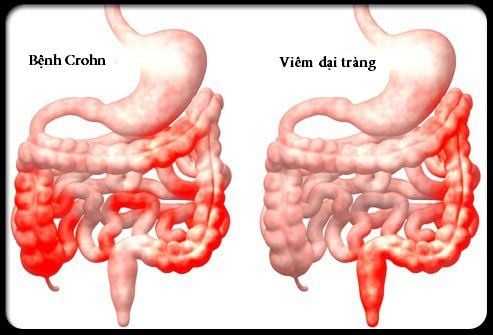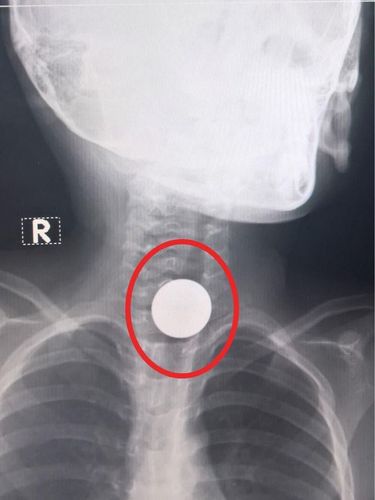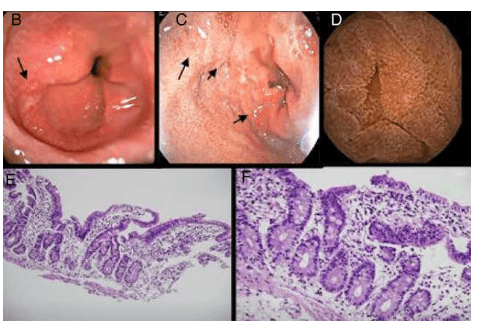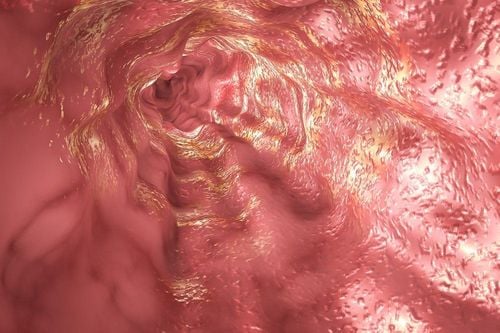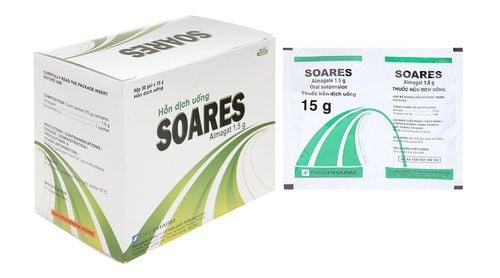This is an automatically translated article.
Articles written by MSc, BS. Mai Vien Phuong, Department of Medical Examination & Internal Medicine - Vinmec Central Park International General Hospital
When the body is exposed to allergens, eosinophils will appear in the esophagus, gastrointestinal tract, and small intestine. Eosinophilic esophagitis is an eosinophilic infiltration of the esophagus that causes clinical symptoms. This pathology is characterized by concentric circles appearing in the esophagus on endoscopic observation, the disease can cause symptoms of dysphagia, choking and complications of esophageal stricture and perforation.
1. What is the esophagus? Where is the esophagus located?
The esophagus is the first part of the digestive tube that carries food from the pharynx to the stomach, about 25cm long, relatively mobile, attached to the surrounding organs by loose, flattened structures because the walls are close to it. each other and have a tubular shape when swallowing food. The esophagus is connected to the pharynx at the level of the 6th cervical vertebrae, below the gastric outlet at the cardia, at the level of the 10th thoracic vertebra. The esophagus is located posterior to the trachea, descends to the posterior mediastinum, is located posteriorly. heart and anterior to the thoracic aorta, through the diaphragm into the abdomen, to the stomach.
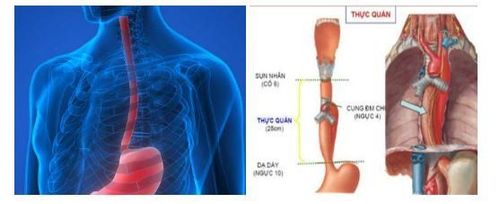
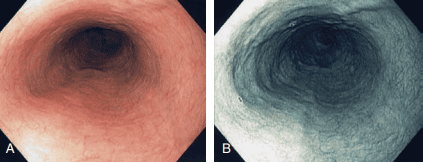
2. What are eosinophils?
Eosinophils are one of the components of white blood cells produced from bone marrow and are one of the cells that play a role in promoting inflammation, especially allergic inflammatory reactions. Therefore, large quantities of eosin can accumulate in tissues such as the esophagus, stomach, small intestine and sometimes in the blood when such individuals are exposed to the allergen.Eosinophils in particular and white blood cells in general have the following characteristics:
Transvascular: Capable of changing shape, penetrating the cell wall to move to places where white blood cells are needed. Movement: Capable of moving with a prosthetic leg (amoeba-like) at a speed of 40 mm/min. Responsive to chemotactic and thermodynamic stimuli: When there are substances produced by inflammatory tissue or by bacteria or there are chemical substances introduced from the outside into the body, attracting eosinophils to the body. , or drive leukocytes further away. Phagocytosis: Capable of phagocytosis, phagocytosis. However, the phagocytic capacity of eosinophils is weak.
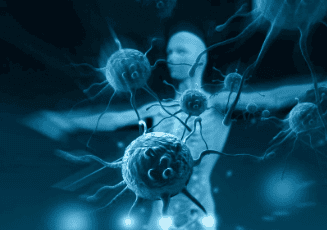
3. Eosinophils in the gastrointestinal tract
Under normal conditions, eosinophils (BCAT) can be found in different parts of the gastrointestinal tract, except the esophagus. These cells play an important role in the innate immunity mechanism with the function of protecting against various invaders. Eosinophilia in the gastrointestinal tract can be seen in many diseases such as infections, parasites, chronic inflammatory bowel diseases, eosinophilic syndromes, connective tissue diseases, myeloproliferative diseases malignancy, hypersensitivity to drugs. If it is not due to the above causes, it is necessary to consider whether it is eosinophilic gastroenteritis. This is a diagnosis based mainly on histopathology with elevated BCAT counts in biopsies of gastrointestinal mucosa and exclusion of causes of local elevation of BCAT.
4. Eosinophilia in the esophagus can be seen in what diseases?
Normally, the lining of the esophagus may have some lymphocytes but no eosinophils. In the presence of allergic inflammation, the epithelial cells of the mucosal layer hyperplasia and the appearance of eosinophils begins. The presence of eosinophils in the esophageal epithelium is called esophageal eosinophilia. However, based on histopathology alone, the diagnosis of eosinophilic esophagitis (VTQDBCAT) cannot be confirmed. This condition can also be seen in other diseases of the esophagus such as gastroesophageal reflux disease (GERD), eosinophilia in response to proton pump inhibitors (PPI REE). ), spasm of the heart or some extra-esophageal diseases such as Celiac disease, Crohn's disease, infection, eosinophilic syndrome, increased drug sensitivity, vasculitis, pemphigus, connective tissue diseases, discharge transplant.... In 2007, the first consensus in the world on VTQDBCAT did not clearly state the definition of this pathology, but in the second consensus released in 2011, VTQDBCAT was defined as a chronic esophageal disease. immunological/antigenic disease characterized by symptoms associated with esophageal dysfunction and inflammation with a predominant presence of eosinophils on histopathology. This definition is still agreed upon in the following recommendations of the American Gastroenterology Association in 2013 and the European Gastroenterological Society in 2017.
The American Gastroenterology Recommendation 2013 emphasized if increased BCAT is found in the esophagus. It is necessary to identify 3 common possibilities: VTQTCAT, reflux esophagitis (GERD) and increased esophageal BCAT in response to PPI antisecretory drugs (PPI-REE for short).
5. Eosinophilic esophagitis
Eosinophilic esophagitis (VTQDBCAT - Eosinophil Esophagitis - EoE) is an eosinophilic infiltration in the esophagus causing clinical symptoms. This pathology is characterized by concentric circles appearing in the esophagus on endoscopic observation, which can cause symptoms of dysphagia, choking and complications of esophageal stricture and perforation.
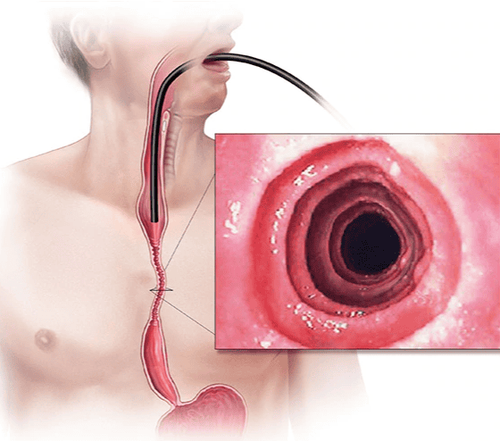
6. Pathology of reflux esophagitis
Esophagitis is an inflammation of the lining of the esophagus, the part of the digestive tract that connects the throat to the stomach, which is responsible for bringing food into the body. It can be caused by acid reflux, an infection, a side effect of certain medicinal products, or a food allergy that makes it difficult to swallow, causing chest pain.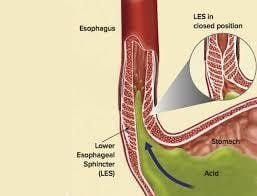
7. Esophageal BCAT elevation in response to PPIs (Proton Pump Inhibitor – Responsive Esophageal Eosinophilia, PPI-REE)
Between 1993 and 2008, eosinophilic esophagitis (EoE) and GERD were treated as separate entities: Esophageal esophagitis on exposure to increased acidity in food esophageal pH monitoring or response to proton pump inhibitor (PPI) therapy would be diagnosed as GERD, while normal pH monitoring or failure to respond to PPIs would be diagnosed as GERD. EoE. Guidelines updated in 2011 described a new phenotype, proton pump inhibitor-responsive esophageal eosinophilia (PPI-REE), referring to patients who appear to have clinically EoE , but was in complete remission after PPI treatment. Currently, PPI-REE must be formally excluded before EoE is diagnosed, as 30-40% of patients with suspected EoE are eventually diagnosed with PPI-REE.
Interestingly, PPI-REE and EoE remain indistinguishable based on clinical, endoscopic and histological findings, esophageal pH monitoring, and measurements of histological markers and inflammation-related cytokines eosinophils, the acid-suppressing ability of PPI therapy, is becoming obsolete. There is growing evidence that PPI-REE is genetically and phenotypically indistinguishable from EoE and that PPI therapy alone can completely reverse allergic inflammatory symptoms. As such, PPI-REE may constitute a subtype of EoE and PPI therapy may be the first step of treatment and diet/steroid may represent advanced therapy. It is possible that the term PPI-REE will soon be replaced by a PPI-responsive EoE. The mechanism why some patients respond to PPI therapy (PPI-REE) while others do not (EoE), remains to be elucidated.
Many studies have tried to find a way to differentiate between PPI-REE and VTQDBCAT. Both diseases have similar clinical, endoscopic and histopathological features. Antacids themselves also have anti-inflammatory effects, and some recent studies have shown that PPI treatment reduces Th2 immune-mediated inflammation in PPI-REE patients similar to remission. reduction in patients with VTQDBCAT during topical steroid therapy.
There are several features that can help distinguish GERD from VTQTBCAT. The common difference is that the esophageal pH measurement of VTQTBCAAT will be normal, GERD will have abnormal results, GERD patients will have a good response to anti-acid drugs, and VTQTBCAT patients will almost not respond. response to this drug. Endoscopic image of VTQTBCAT with characteristic images and concentric rings of the esophagus, under the microscope, there are many eosinophils (more than 15 eosinophils per field), and for In patients with GERD, it is mainly a Z-line scratch and very few eosinophils (less than 5 eosinophils per field).
However, it should be noted that both GERD and VTQDBCAT are common in young patients and can sometimes co-occur in the same patient. In patients with esophageal dysfunction for which the diagnosis of GERD has been established by endoscopy or pH measurement, VTQDBCAT cannot be completely ruled out. The relationship between GERD and VTQDBCAT is complex and can be bidirectional. It is hypothesized that when a patient has GERD, the permeability of the esophageal mucosa changes, making it more susceptible to the effects of allergens and triggering an immune response. In contrast, in patients with VTQDBCAT, there was increased sensitivity to the presence of acid on the esophageal mucosa compared with healthy subjects. Thus, VTQDBCAT can also induce structural and functional changes in the esophagus and cause secondary GERD.
To proactively protect your health, you should check your general health regularly. Currently, Vinmec International General Hospital has general health checkup packages suitable for each age, gender and individual needs of customers with a reasonable price policy, including:
Health checkup package overview Vip Standard general health checkup package Patient's examination results will be returned to your home. After receiving the results of the general health examination, if you detect diseases that require intensive examination and treatment, you can use services from other specialties right at the Hospital with quality treatment and services. outstanding customer service.
Please dial HOTLINE for more information or register for an appointment HERE. Download MyVinmec app to make appointments faster and to manage your bookings easily.
ReferencesLandres RT, Kuster GG, Strum WB (1978). Eosinophilic esophagitis in a patient with vigorous achalasia. Gastroenterology, 74(6): 1298 - 1301. 2. Lucendo AJ et al (2017). Guidelines on Esophageal eosinophiliaevidence based statements and recommendations for diagnosis and management in children and adults. United European Gastroenterol J, 5(3): 335-58. 3. Straumann A, Spichtin HP, Bernoulli R et al (1994). Idiopathic eosinophilic esophagitis: a frequently overlooked disease with typical clinical aspects and endoscopic findings. Schweiz Med Wochenschr, 124: 1419 -29. Hirano I, Moy N et al (2013). Endoscopic assessment of the esophagus features of eosinophilic oesophagitis: validation of a novel classification and grading system. Gut, 62(4),: 489 -95






